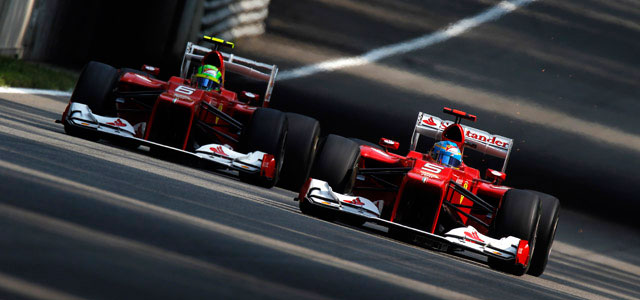
The F2012 is the fifty eighth car built by Ferrari with the express purpose of taking part in the Formula 1 World Championship. It adopts a well established tradition of being named after its year of manufacture.
The project, which goes by the internal code number of 663, constitutes the Scuderia’s interpretation of the technical and sporting regulations that apply this year: the main changes when compared to 2011 concern the height of the front section of the chassis, the position of the exhaust pipes and the mapping for the electronic engine management.
Practically every area of the car has been fundamentally revised, starting with the suspension layout: both the front and rear feature pull-rods, aimed at favouring aerodynamic performance and lowering the centre of gravity. The front wing is derived from the one introduced on the 150º Italia in the final part of its racing life and has been evolved from there.
Subscribe to Racecar Engineering
Keep up with the latest developments in motorsport technology with Racecar Engineering, the world’s leading publication for technical insight.
Save up to £33 when you subscribe and never miss an issue
Choose from our Print, Digital and iPad editions
Further evolutions are planned in this area for the opening races of the season. The nose has a step in it that is not aesthetically pleasing: with the requirement from the regulations to lower the front part, this was a way of raising the bottom part of the chassis as much as possible for aerodynamic reasons. The sides have been redesigned, through modifications to the side impact structures, the repositioning of the radiators and revisions to all aerodynamic elements.
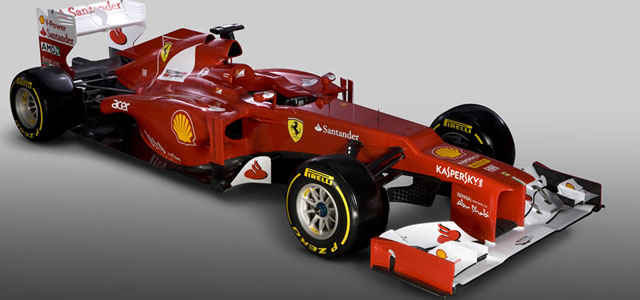
The lower part of the rear of the car is much narrower and more tapered, a feature achieved partly through a new gearbox casing and a relocation of some mechanical components. In recent years, the area of exhausts has been crucial in terms of car performance and much effort was expended on this front, based on changes to the regulations introduced this year. The rear wing is conceptually similar to the one used in 2011, but every detail of it has been revised and it is now more efficient. Naturally, it is still fitted with DRS (a drag reduction system,) which is operated hydraulically. The front and rear air intakes for the brakes have been redesigned and work was carried out in collaboration with Brembo to optimise the braking system.
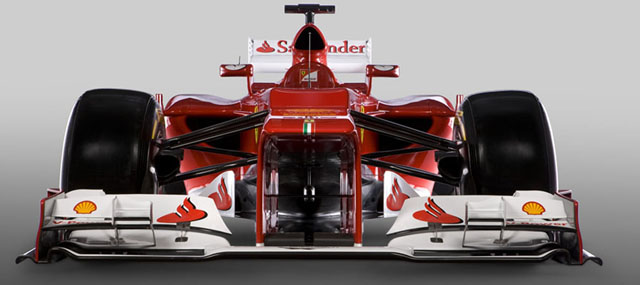
The engine in the F2012 is an evolution of the one that powered last year’s car, which is inevitable given that the technical regulations forbid any modification to internal components aimed at increasing performance. Furthermore, much effort has gone into improving its installation in the new chassis, so as not to penalise the aerodynamics of the car. Another area on which the Maranello engine specialists have been working is performance drop off, with the aim of maintaining the highest possible performance level throughout each engine’s cycle of use, which has now reached an average life of three races. The electronic management of the engine has been revised based on the modifications to the rules regarding the use of exhaust gases, a task that has required a great deal of attention and many hours on the test bed. The kinetic energy recovery system maintains its low central location in the car – a choice also aimed at maximising safety – and has undergone an update directed mainly at reducing its weight and at improving the efficiency of some of its components. Several decades of technical collaboration with Shell has seen further progress on the fuel and lubricants front, revolving around improving performance in absolute terms and on durability over the life cycle of the engines, as well as reducing consumption. As usual, great attention has been paid to the electronics on the car, especially in terms of reducing weight and, obviously, reliability.
As always at Ferrari, a great deal of time has been devoted to the performance and optimisation of the materials used, right from the design stage of each of around six thousand components that make up the car. In part, this is done to ensure that all operations carried out at the race track are as efficient and effective as possible. Obviously, quality control remains a crucial aspect, as does the goal of reaching maximum levels of performance and reliability, while maintaining the highest possible safety standards.
With a reduction in the number of days available for track testing before the start of the Championship, which has dropped from fifteen to twelve, preparatory work on the test beds prior to the car’s track debut, has taken on even more importance. The three test sessions – at Jerez de la Frontera and Barcelona – will serve to get a picture of the handling of the F2012 and to adapt it to the Pirelli tyres. Indeed, getting the most out of the tyres has been an area that has seen a lot of work both at the design stage and in how the activities at the track are to be managed. The car is due to undergo a very intensive development programme over the first part of the season, especially on the aerodynamic front.
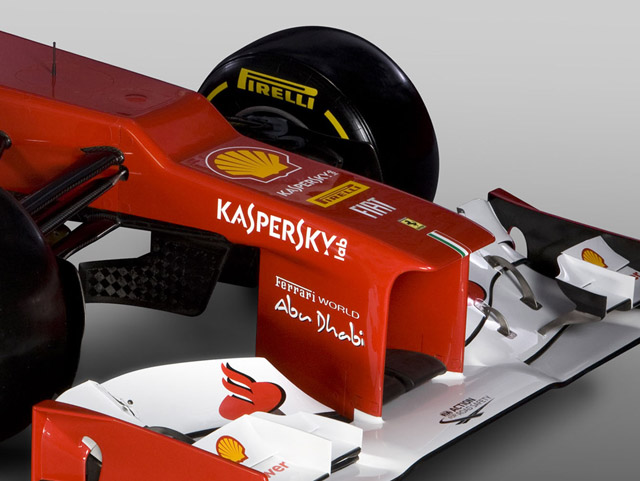
There is likely to be much discussion about the 663’s nose design, where the front of the monocoque meets the nose. This is something that is typical of the 2012 cars but unusually the Ferrari has the space between the ‘turrets’ filled in, whilst others like the Force India VJM05 and Caterham CT01 have it open. The deep nose supports with the twin camera mounts inside are a direct carry over from the 2011 car, at least in terms of concept.
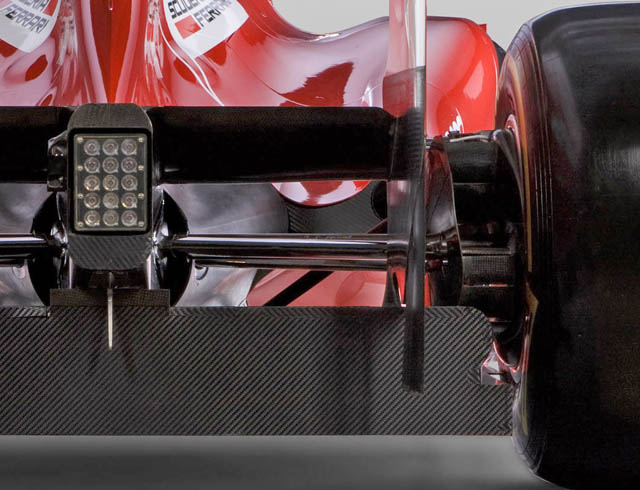
The 663 features pull rod suspension, a major change from the 2011 car. With the 2012 regulation changes essentially outlawing blown floors the rear area of the cars revert pretty much to early 2009 specification (before everyone noticed the double diffusers fitted to the Brawm, Toyota and Williams). This makes a pull rod layout more attractive at the rear. As was the case with the McLaren the diffuser has been blanked off to prevent prying eyes getting a look before the first test at Jerez. Note the exhaust exit location just visible in the picture above.
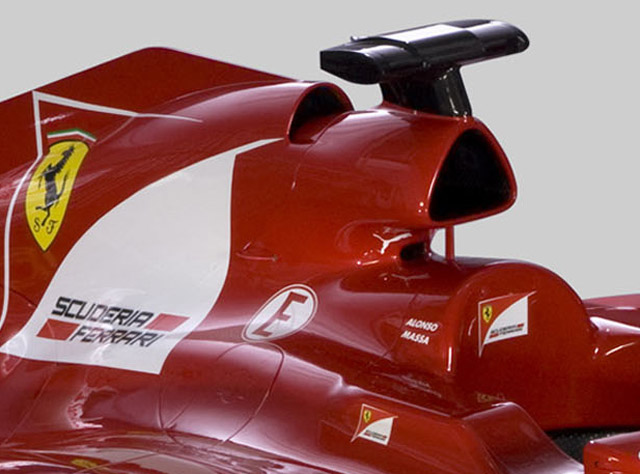
On the roll hoop/engine cover the 663 features a cooling duct for the gearbox heat exchanger. Very similar in concept to the one found on the McLaren MP4-26 (below)
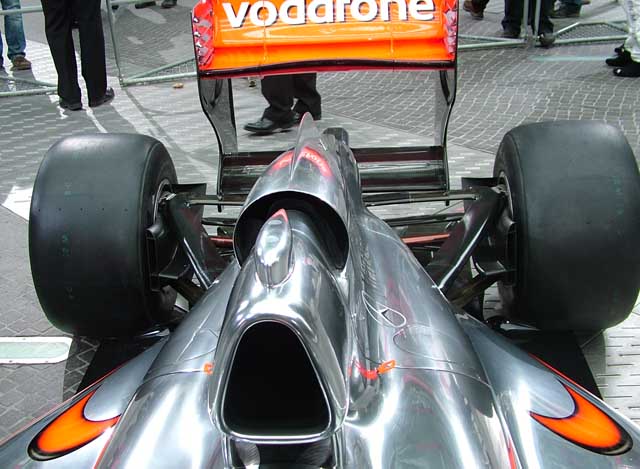 Further images released by Ferrari from the cars rather quiet launch event show the 663’s pull rod front suspension arrangement better. The design is the talk of the F1 paddock already with many engineers scratching their heads about how it could possibly work.
Further images released by Ferrari from the cars rather quiet launch event show the 663’s pull rod front suspension arrangement better. The design is the talk of the F1 paddock already with many engineers scratching their heads about how it could possibly work.
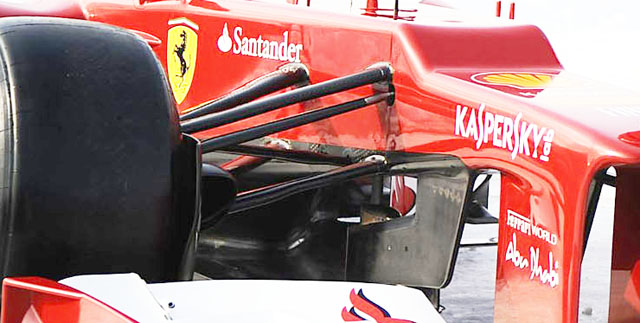
The pull rod runs downward from near the top of the upright to the base of the chassis where it is likely the torsion bars and dampers are mounted. A first look at the cars bulkhead will be very revealing.
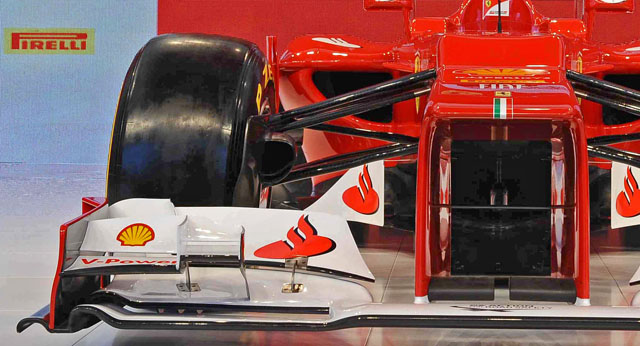
Test 1: Jerez
Ferrari’s F2012 made its track debut at Jerez, and the team was focussed on evaluating some of the new concepts featured on the car. What was different about the test was the work carried out by the team when compared to other debuts in the recent past, as Nikolas Tombazis explained. “This car represents a clear break with the one that preceded it and it features concepts that are very different for us and that require much more fine tuning. That’s why today we absolutely did not have an eye on the stopwatch, preferring to concentrate on gathering as much data as possible in order to get as good an understanding as possible of the behaviour of the car. We have much to do, but all in all, there are reasons to be pleased with the three hundred kilometres that we put together with Felipe at the wheel. We had to experiment with different solutions and that will be the case for the next few days as well: it’s obvious that some delivered what was expected while others did not, but that’s the purpose of testing, getting to understand how a car behaves and how best to develop it. We decided that the only way to make a step forward was to be much more aggressive in our approach to the design of the car. It is obviously too early to say if this year we will be able to win or not, but no one will be able to accuse us of having been timid in the design of this car.”
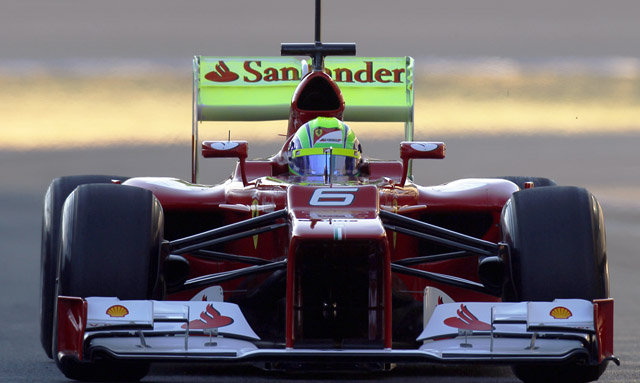
The team spent a lot of time on flow visualisation, far from unusual at the first test of the season, here the rear wing is covered in the bright green dye.
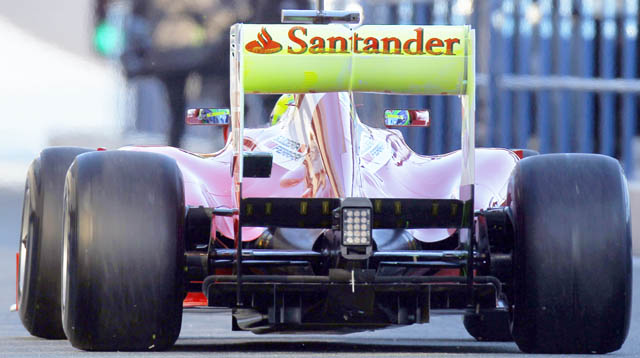
A lot of attention has also been paid to thermal management at the rear of the car, nor the temperature strips along the lower element of the rear wing. Also here you can see the extra element above the diffuser employed on the Ferrari. The bulge on the left wing end plate is a sensor.
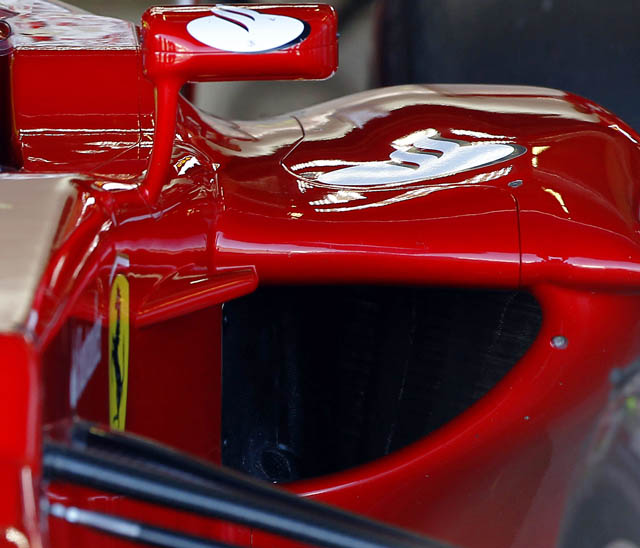
Taking a look at the shape of the top of the sidepods on the car you can see the dip toward the car centre line and a flatter outer section to house the radiators. McLaren has a similar concept on its car but the shape is far smoother (below)
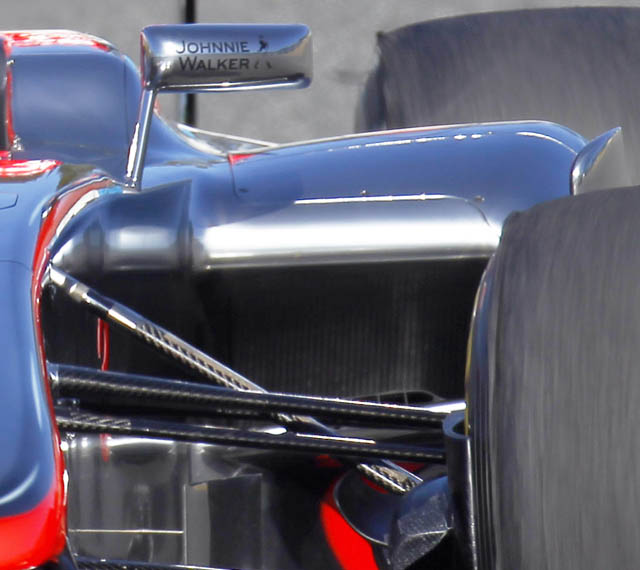
On the outer edge of the sidepod Ferrari is experimenting with double element flow conditioners.
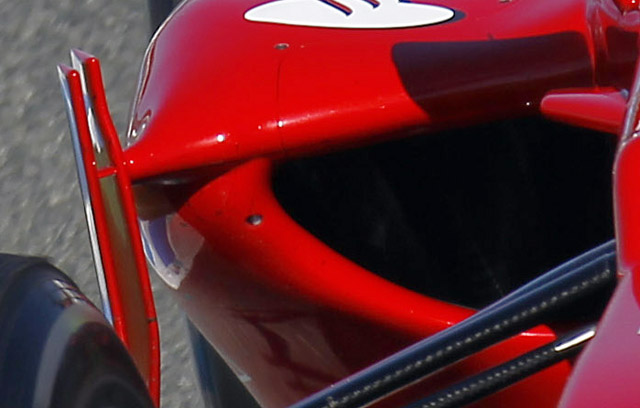
The exhaust layout of the F2012 is similar to McLaren’s in location but not in shape and concept though less extreme – with a channel facing upwards. Ferrari is likely to update these locations. Note the temperature strips on the upper rear wishbone and the other sensor further outboard (below).
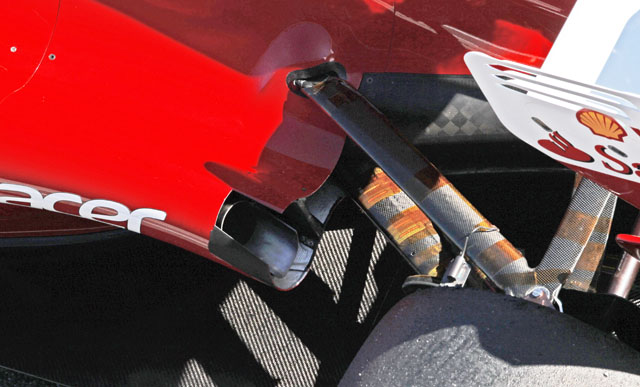
Wri2 / Jad Sherif
Test 3: Barcelona
Ferrari worked on the set-up of the F2012 and on aerodynamics throughout the test experimenting with different bodywork configurations and a new exhaust layout. The talk in the paddock is that the team is struggling with the new car and is not expected to be competitive in Melbourne. However the lap times seem fine.
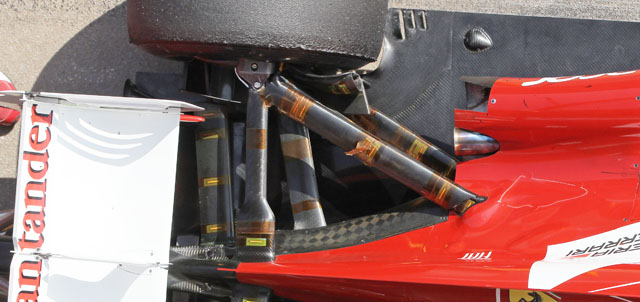
Ferrari continues to battle with its exhaust layout trying another position at Barcelona. This installation looks a bit hasty and retains the void left by the previous position (below). Note also the gills in the floor ahead of the rear wheel.
 A third installation was also tested which was part way between the two pictured above.
A third installation was also tested which was part way between the two pictured above.
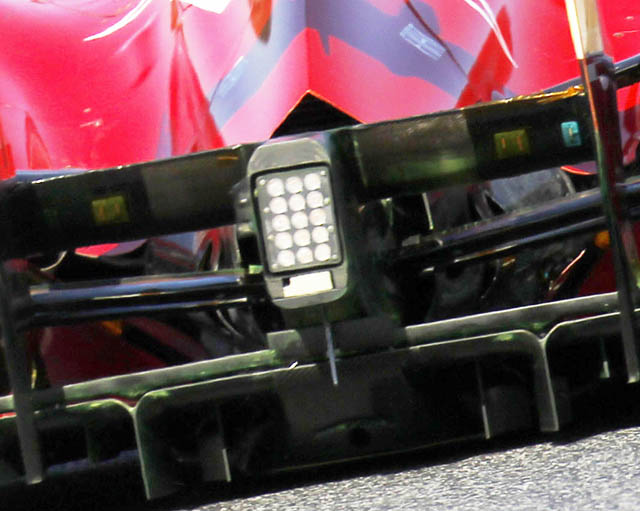
The rear cooling outlet has also been revised and again the bodywork finish looks rather rushed. The simple triangular outlet looks nowhere near as refined as other solutions down the pit lane, however looks can be deceiving.
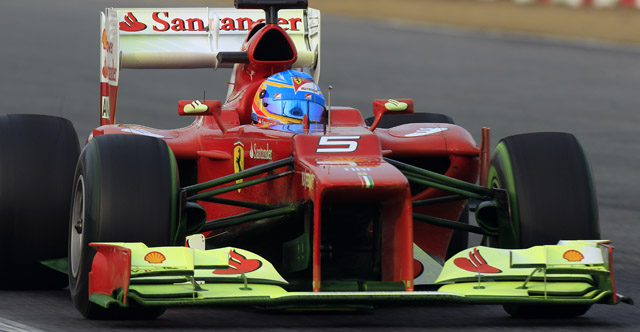
Much time was spent on aero runs, and there was liberal application of flow vis in many areas.
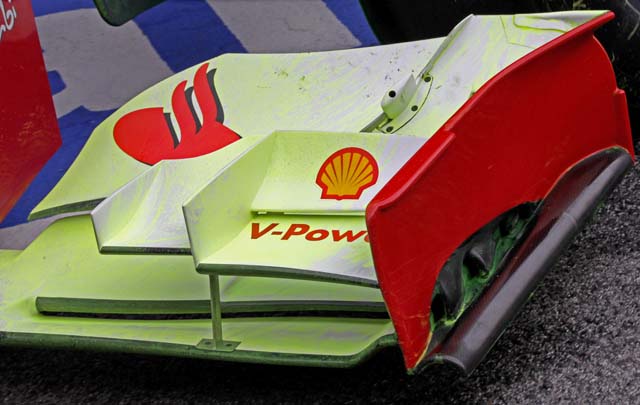
This included the new front wing endplates (above) which are far more complex in design than the launch spec version (below).
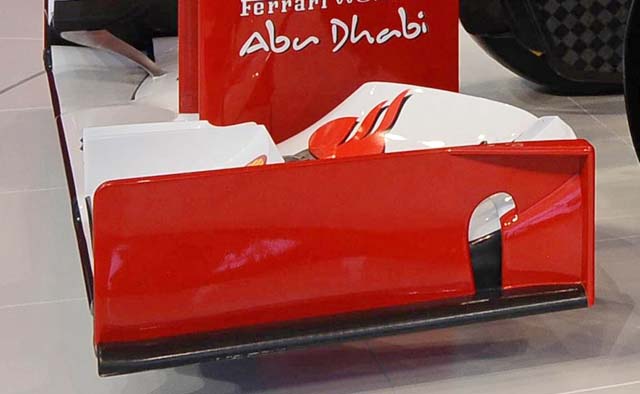
The F2012 was also fitted with new wing mirrors it is not clear if this is for aerodynamic reasons or simply driver preference.

The newer mirrors are lower and seemingly more in the drivers line of sight, this is clearly noticeable when compared with the original position (below)

Melbourne
Car 5: 295
Position: 5th
Driver: Fernando Alonso
Car 6: 293
Position: DNF (Collision)
Driver: Felipe Massa
The Ferrari F2012 seems to have a bad handling characteristic. It seems to lack grip and is working the rear tyres too hard causing them to wear very fast.

A new rear wing endplate was fitted to the car, complete with small external strakes (above).
Sepang
Car 5: 295
Position: 1st
Driver: Fernando Alonso
Car 6: 294
Position: 15th
Driver: Felipe Massa
Felipe Massa switched chassis following the Australian Grand Prix, in an attempt to improve performance. It didn’t work. In Qualifying chassis 295 (Alonso) suffered some kind of KERS problem not uncommon at Sepang with its very high ambient temperatures. To deal with those temperatures, the F2012 was fitted with additional cooling gills
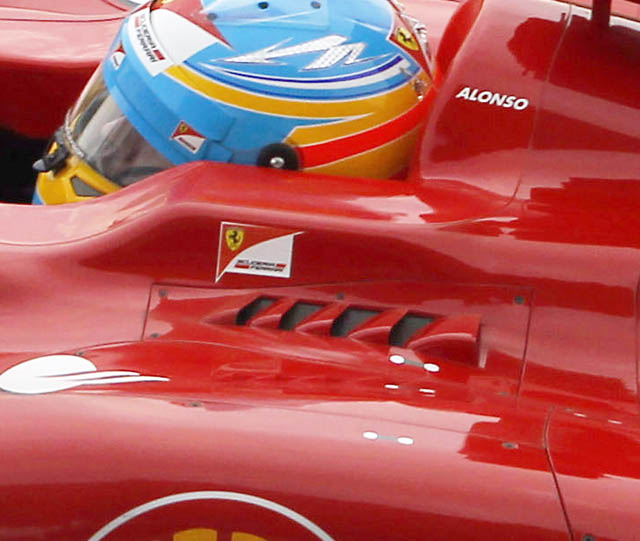
A look at the cake tin of the F2012 reveals some nice sculpted ducting and the well integrated brake caliper.
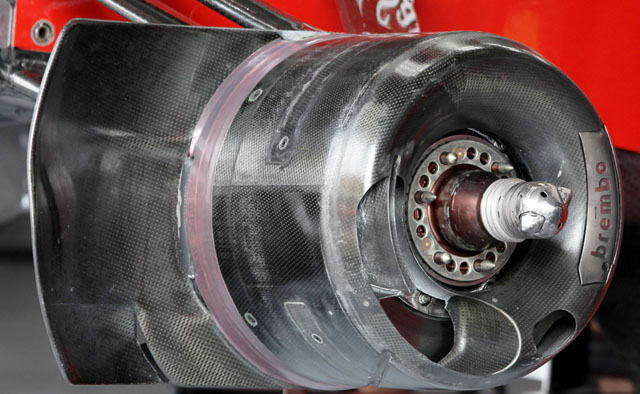
On winning the race Fernando Alonso celebrated by showing the assembled photographers his steering wheel. Here it is.
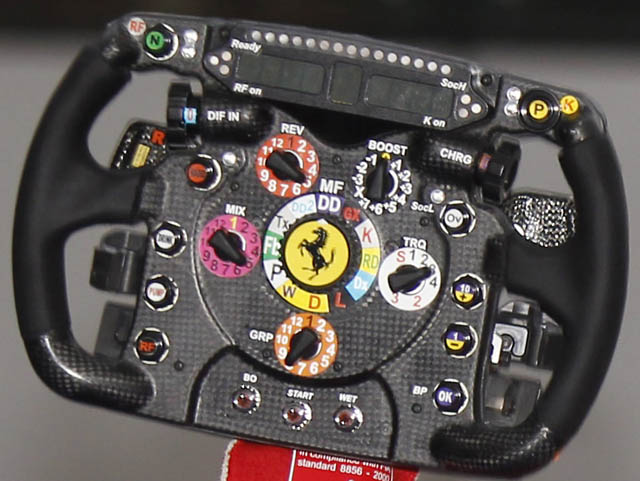
Shanghai
Car 5: 295
Position: 9th
Driver: Fernando Alonso
Car 6: 294
Position: 13th
Driver: Felipe Massa
Stefano Domenicali: “There’s no point denying we are disappointed. We had the potential to get a better result than this, but we did not manage it. The lack of top speed, one of the weak points of this F2012, prevented Fernando especially of making the most of a strategy, which at one point, had put him in a situation where he could fight for a place in the top five. Felipe went for a two stopper, counting on others having higher tyre degradation, but this only turned out to be the case for a few cars. It was quite an unusual race, as indeed was qualifying, which still delivered some surprises compared to what was being predicted and I think it is worth analysing the way it went in depth to try and understand how best to tackle the next round. In Bahrain we will again have to be racing on the defensive but that doesn’t mean we will go there in a resigned state of mind. We have seen three different winners in three races, with performance levels of some cars changing very significantly from race to race. At this stage, we must do the maximum on track and exploit every opportunity, but the most important work is that done in Maranello, especially on the aerodynamic development. We need to accelerate the introduction of updates and change gear.”
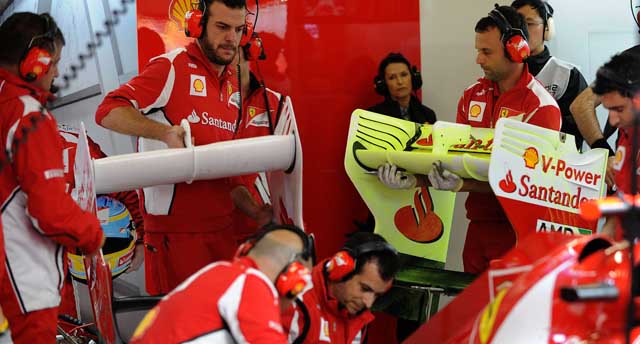
The Ferrari was fitted with a new rear wing – compare the new spec (right with flow vis) with the old (left). The structure of the main plane and flap are notably different (below). The end plates were also revised with and additional vent added.

Ahead of the wing mirrors a pair of small flow conditioners have appeared (below).
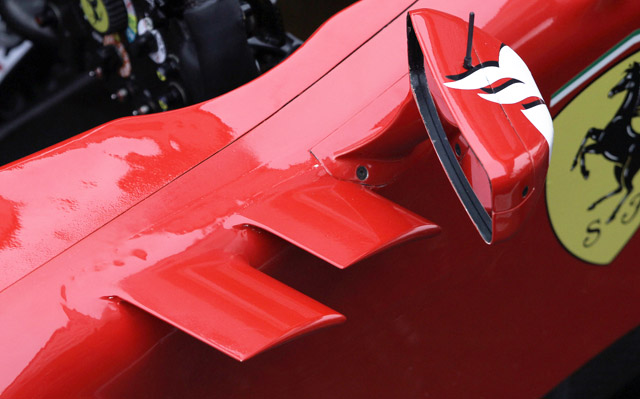
The Ferrari bulkhead is very simple compared to that of other teams, the pullrod front end giving a very different layout (below).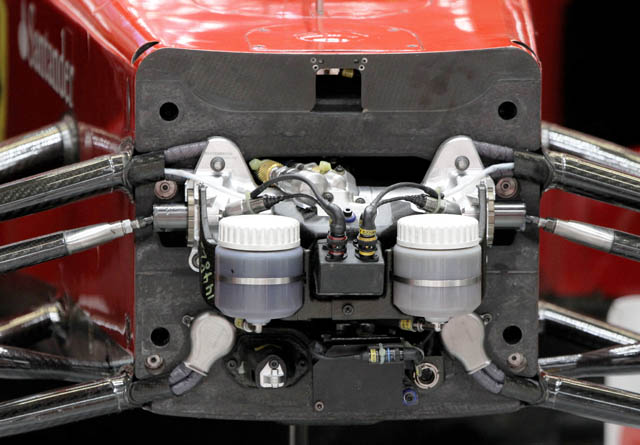
Sakhir
Car 5: 295
Position: 7th
Driver: Fernando Alonso
Car 6: 294
Position: 9th
Driver: Felipe Massa
Stefano Domenicali, Team Principal: “Honestly, what happened on the track today is only of secondary importance for us. We are very sad to learn of the death of Matteo Vignali, a young man who worked in the Gearbox department, who suffered a heart attack. He lost his life at just thirty two years of age, something that leaves us in a state of dismay. Our thoughts are with his family and friends and because of this, I find it hard to comment on our actual race result. What I can say is that what has been a very tough first run of races for us has now come to an end, although this is just what we had expected. We managed to limit the damage, at least as far as the Drivers’ championship is concerned. Now we must look to the future and make a step up in terms of quality which should allow us to fight for the podium and not just a points finish. That’s what I have been asking our engineers for several weeks and by Barcelona, I expect to already see the results of the effort we are expending in every area.”
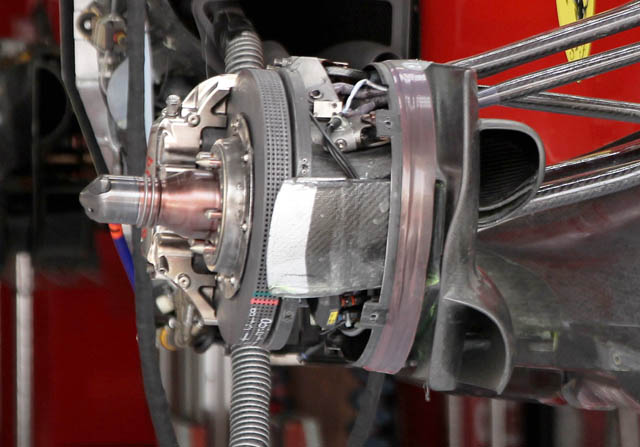
A look at the Ferrari brake setup – note the many tiny drillings in the disc – where some teams go for much larger cooling shapes inside the disc.
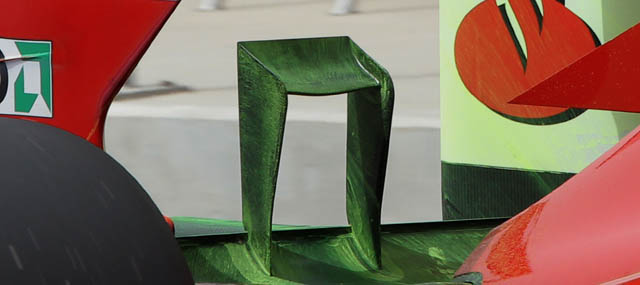
Ferrari added a monkey seat wing to the rear of the car – seen here covered in flow vis paint.
Test 4: Mugello
Car: F2012
Drivers: Fernando Alonso, Felipe Massa
Ferrari’s programme centred on experimenting with some new aerodynamic components introduced on the F2012, as well as a study of the behaviour of the Pirelli tyres. The F2012 had a very heavy rear end update fitted on the final day of the test with an all new exhaust layout far neater than previous versions.
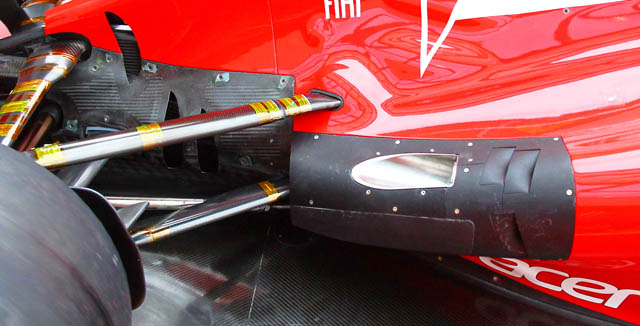
Additional ducting has appeared in the form of gills along the rear of the car some behind the exhaust which could be considered flow capture ducts, which are specifically outlawed in technical directives issued after the technical regulations were published.

A small change was made to the base of the turning vane (above) with a smaller vane added to the protrusion.

The floor of the F2012 has a number of very fine vents in it also notice the very slim duct (partially blanked in this shot) just inboard of the exhaust exit where the plain carbon panels meet the red bodywork.
The engine cover has gained a hump, it has been suggested that this is part of Ferrari’s attempts at the DDRS and that the gerbox cooler duct serves some purpose in that system, though this is pure speculation.
Barcelona
Car 5: 295
Position: 2nd
Driver: Fernando Alonso
Car 6: 294
Position: 15th
Driver: Felipe Massa
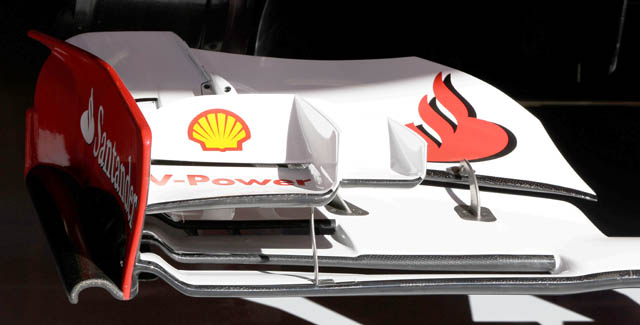
Ferrari revised the F2012’s front wing, with a number of small detail changes. Compare the new (above) with the old (below)
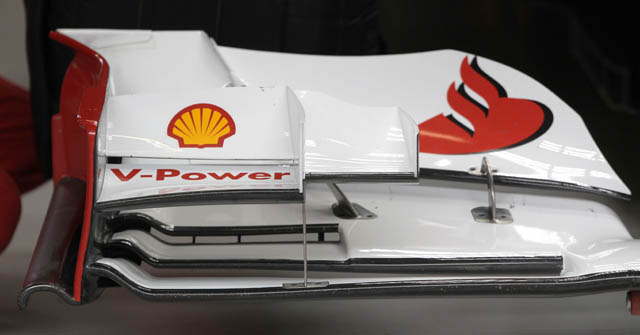
Monaco
Car 5: 295
Position: 2nd
Driver: Fernando Alonso
Car 6: 294
Position: 15th
Driver: Felipe Massa
Stefano Domenicali: “First of all, I want to say that all our thoughts are with everyone who is suffering as a result of the earthquake that hit the Emilia region last week: we hope that this strong race from Ferrari will have allowed them, just for a couple of hours, to forget their troubles at such a difficult time. We are with you, in thought and deed, because our roots are there, in the ground that has continued to shake there for the past eight days. As for the race, we leave the Principality with a very positive result and, above all, with Fernando Alonso leading the Drivers’ classification and Felipe Massa having delivered a brilliant and feisty performance all weekend long. Both our drivers did a great job, from the first to the last lap and the team behind them was a match for the situation. I am particularly happy for Felipe who needed a positive result: I’m sure this weekend really represents a fresh start to the season for him. We have to be satisfied, but we must definitely not relax, especially as we are not yet the best in terms of performance, particularly in qualifying. As I usually say after a good weekend, keep calm and carry on!”
Pat Fry: “A very intense race, which ended with one car on the podium and the other in the top six. There was not a moment’s respite, right from the start, with the top six all together in just a handful of seconds. We all started a bit blind in terms of how the tyres would behave, both as far as durability was concerned and how they would perform in the first laps of use. Furthermore, the rain was always lying in wait and appeared right in the final moments. Fernando and Felipe both drove impeccably, without making the slightest mistake, as was the case for the crew during the pit stops. As for the strategy, day after day, the option of the one stop became ever more clear and, in the end it was the best choice.
Sure, with hindsight, it’s easy to say that if Fernando had stayed out on track for a few laps more, then maybe he could have also passed Rosberg and got on terms with Webber as well as Hamilton, given the time he did on his in- lap. I think this weather was a surprise for everyone, as was the difficulty encountered in getting the Softs up to temperature in their first laps. With just a few seconds to react, we took the most logical decision, which did all the same lead to a podium finish. It all goes to show how every detail is crucial in a championship as closely contested as this one. We need to continue pushing on the development of the car, because we are still not where we want to be in terms of performance.”
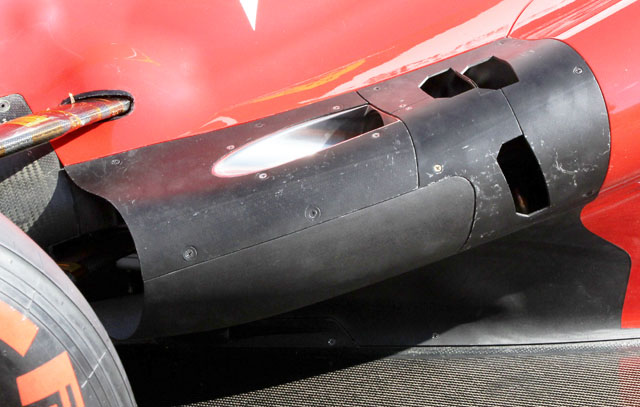
At Monaco Ferrari again revised the exhaust exit on the car. A conventional periscope style exit was fitted, note the additional cooling outlets forward of the exit, these are linked together by small slits – just visible here, and forward to the exhaust exit making sure that they comply with the single opening regulation, in other words this is just one hole!

A good look at the front brake setup of the F2012 in Monaco trim.
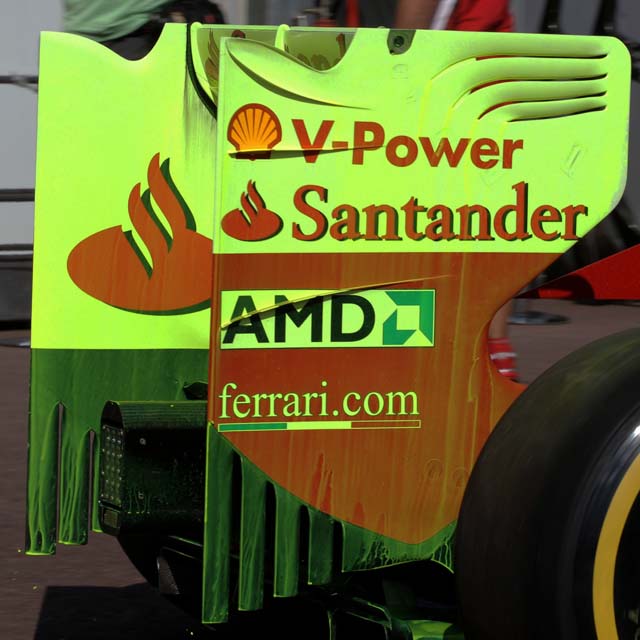
As at many other races the Ferrari team was liberal with the application of flow vis paint.
Montreal
Car 5: 295
Position: 5th
Driver: Fernando Alonso
Car 6: 294
Position: 10th
Driver: Felipe Massa
Pat Fry: “We had a lot of work to get through today and we were worried the rain might come, which could certainly have made life complicated. Fortunately, the expected storm hit immediately after the end of the second practice session, so that we were able to get through everything we had set ourselves to do. We brought two different exhaust configurations here: one was the one used in the last two races, the other represents our latest interpretation of the concept that was part of the car when it made its debut in Jerez. From what we could see today, the latter configuration seems to be positive in terms of performance even if, obviously, we need to analyse the data very carefully to make the right choices for the race.
We are working very hard on developing the F2012 and we can now see tangible signs of progress. That is down to all our people, from those in the wind tunnel to those who manufacture the parts to ever tighter deadlines, without forgetting all the other departments and I wish to thank them all for their efforts. We must continue down this route, because while we have managed to close a good part of the gap which separates us from the best, it’s also true that we’re not yet on top. We have various updates here and the majority of them have lived up to our expectations and this too is a positive sign.
Stefano Domenicali: “There’s a certain feeling of disappointment this afternoon and there’s no point denying it. It’s the first weekend in which we have not got the most out of what we had, but it’s also down to the fact that the level of expectation was higher thanks to the progress we have made. Let’s not forget that yesterday we were fighting for pole and today, we were in the battle for the win right to the end: in Bahrain, a month and a half ago, not a year ago, we only got one driver into Q3 and we finished the race one minute off the winner. Today, we made two mistakes: we did not cover Vettel when the German stopped the second time and Felipe’s spin in the early stage of the race. All things considered, the first error cost us relatively little, while the second came at a higher price, because Felipe, who nevertheless had another good weekend after the one in Monaco, had the pace to stay with the lead group. Having made this preliminary analysis we need to look at the weekend in terms of the championship. Fernando is only two points off the leader and the F2012 is back to being competitive enough to fight with the best. However it was important to score points on a track that, going into the event, was definitely not one that suited us: knowing we can count on a driver like Fernando, capable of completing a year’s races all in the points is a factor that has its part to play when it comes to thinking about the title race. We must continue to push on the development to close the gap which still separates us from pole position: only when we have done this can we claim to have reached our first objective. Another theme we need to look into further is the tyre degradation, which is proving to be ever more the key to this season.”
Pat Fry: “To finish a race struggling with the tyres always hurts a bit, but for we engineers it’s best to evaluate the situation with a cool head and not with the emotive images from the television in mind. Today, Hamilton was quicker and the fact we were able to pass him was down to the strategy, by trying to do something different. Furthermore, given the behaviour of the tyres at that moment, from a certain point onwards, we decided on going for a single stop to try and at least make it to the podium. We did not manage it, but we tried right to the very end. Maybe we could have shadowed Vettel and come into the pits when he did: that was a mistake which cost us a position, but anyway Fernando would have finished outside the top three. A shame for Felipe, because he showed a good pace: a mistake early on meant he ended up in traffic and the last of the points places is definitely not the result that was within his grasp this afternoon. We leave Montreal convinced we have made a step forward in terms of outright performance, but aware that we did not pick up what was in our reach The F2012 has improved, but it is still not enough and we will have to work a lot on understanding the tyre degradation. We will head for Valencia with the aim of further improving performance and getting the most out of the potential available to us.”
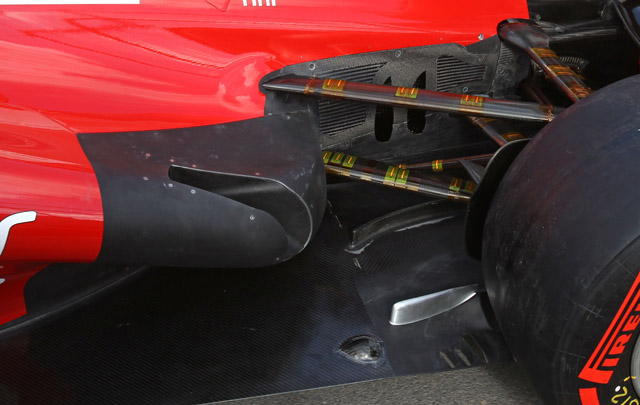
A major update was made on the F2012 in Montreal and was centered on another new exhaust solution. This time very similar to the McLaren solution utilizing the exhaust plume to prevent the vortex from the rear tyre encroaching into the diffuser.
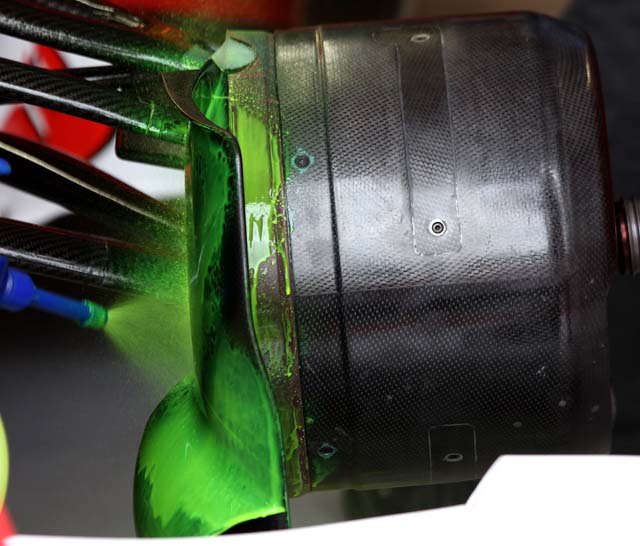
As a result copious amounts of flow vis paint was applied to most surfaces of the cars (above and below)
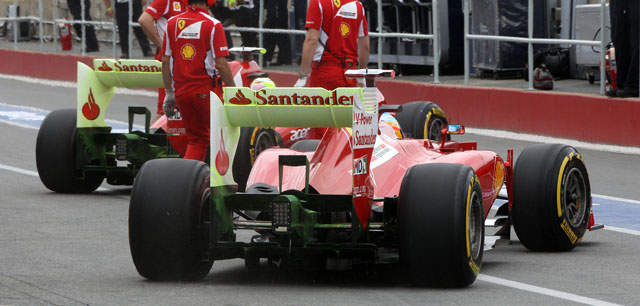
Valencia
Car 5: 295
Position: 1st
Driver: Fernando Alonso
Car 6: 294
Position: 16th
Driver: Felipe Massa
Luca di Montezemolo: “This is Ferrari at its very best, the one everyone wants to see! Fernando was extraordinary and it’s hard to find the words to describe his race. I am very sorry for Felipe, who was really unlucky: he was going very well and I’m sure he could have brought home a good result if not for all the problems he had. Today has shown the spirit of a team that never gives up and it also reflects the spirit of our homeland in Emilia Romagna, where so many people are going through a particularly difficult time after the earthquake a few weeks back: let’s hope this victory will at least have put a smile on their faces!”
Stefano Domenicali: “We are very pleased with this victory, but we won’t let it go to our heads. Yesterday, we had said that the result of qualifying did not reflect our potential and I think today’s performance proves we were right. A shame for Felipe, who really got hit with one misfortune after another, first with debris ruining the balance of his car, then with the fact the Safety Car period came immediately after he had pitted and finally, the collision with Kobayashi: he had started in fine style and had everything in hand to get a really good result. Fernando was spectacular, in terms of showing aggression and in the way he managed the car and tyres. We could tell that this weekend felt very special to him and the win was really emotional for him and the whole team. Today, some of our competitors had reliability problems and that serves as a reminder that this aspect is crucial for success: in such a closely matched season, a no-score carries a high price in the classification. We said it at the beginning: these twenty five points will definitely not go to our heads. We are well aware how things can change in the blink of an eye and we must continue to work on improving the car’s performance, because it is still not at the level we want.”
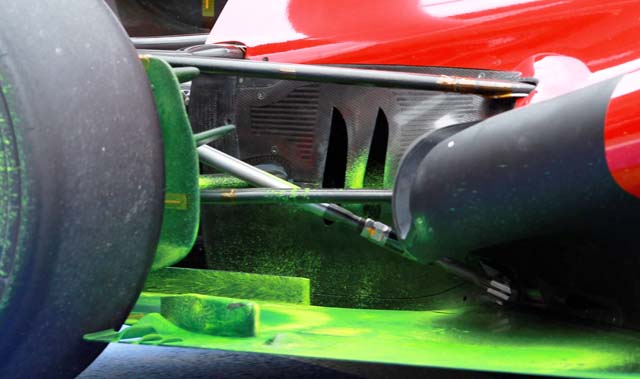
The evaluation of the new exhausts continued at Valencia, with the ever present flow vis paint. The underside of the front wing was coated with paint hand the resulting run coated the front suspension and brake ducts.
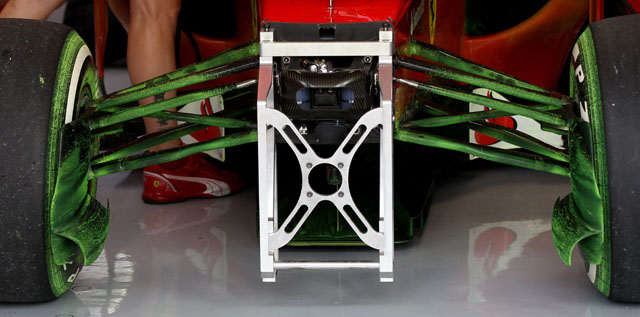
Silverstone
Car 5: 295
Position: 2nd
Driver: Fernando Alonso
Car 6: 294
Position: 4th
Driver: Felipe Massa
Stefano Domenicali: “We have picked up thirty very big points here at Silverstone. Once again, Fernando drove a great race, for the umpteenth time this season and has gained points over the majority of his nearest rivals, but let me tell you that I am particularly happy with the display put on by Felipe, who was in the fight for pole yesterday and for the podium, right down to the last, today. It is a nice result for him, which is particularly important for us in terms of the Constructors’ championship, where thanks to the biggest points haul of the year, we have managed to move up to second place. We also did a good job in terms of the team, both when it came to strategy and how we managed the race on track.
Obviously, when you lose the lead, just a few laps from the end of a race, there’s a hint of regret, at least in the heat of the moment, but then it dawns on you that this is a really important result for both championships. I am glad that the spectators were finally able to enjoy a dry day at the track and were able to witness a great show: here, one can feel that the passion for motor sport is really strong and it is always a pleasure for us to come and race in front of such enthusiastic and knowledgeable fans. We were at the same level as the team everyone reckons is currently the best and be sure, it definitely is. And we also held our own against some very strong competition from other rivals. Certainly, there is much more to do to improve the car, especially in terms of top speed, where we are still suffering. We now come to a pair of back to back races in Hockenheim and Budapest, for which we will try and improve our performance level still further: that will be our primary goal over the next few days.”
Pat Fry “A very close race, from the start to the chequered flag. With Fernando, we were fighting for the win and with Felipe for the podium all the way to the finish, confirming that our package – the team, drivers, car – was competitive at this track. After two days affected by rain, today the skies cleared, but that was not something one could have predicted with absolute certainty the day before the race. We did not have much of a reference point in terms of tyre behaviour, because we only had FP3 in which to assess performance, especially over a long run. That was partly why we opted to run different strategies with our two drivers and, all in all, we have no regrets, given how things went: clearly, on the Softs both Red Bulls were quicker than Fernando and we need to look at how we can improve our tyre performance in similar situations in the future.
Fernando and Felipe both drove impeccably throughout the race, and the pit stop guys were faultless whenever the call came. This championship is very close and so it is vital to always bring home as many points as possible. I think today we achieved that goal and it is very significant that we have managed to make up no less than two places in the Constructors’ classification. We must continue to push on car development, because we are not yet the quickest: there is still much work to do to achieve this objective.”
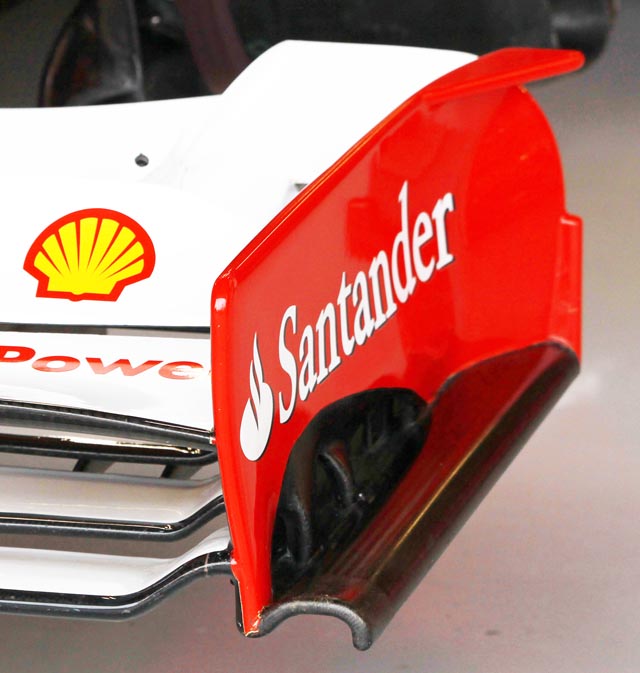
Ferrari Introduced a new front wing at Silverstone, with a different endplate vent layout.
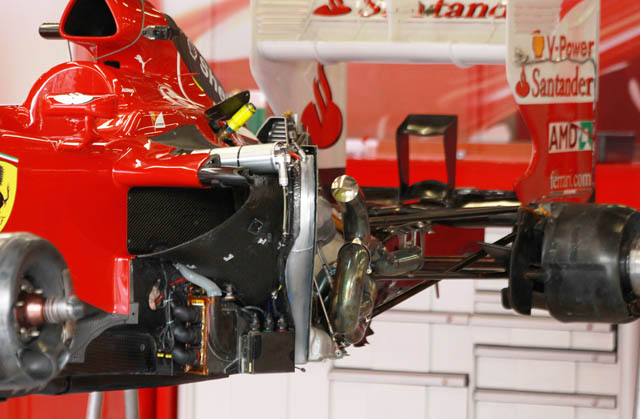
A nice view of the F2012 unclothed, note the electronic control box under the sidepod air duct.
Hockenheim
Car 5: 296
Position: 1st
Driver: Fernando Alonso
Car 6: 294
Position: 12th
Driver: Felipe Massa
Pat Fry: “Once again, Fernando was fantastic. He made the most of pole at the start, then he waited until he had built up a useful window in which to make the first stop and managed to do so ahead of his main rivals. Once he was on the Mediums, the first few laps were rather difficult: both Vettel and Button were able to close up but our driver was brilliant in managing the situation and never once left himself open to an attack. Then it was Button who pitted early, but we had enough of an advantage to be able to react immediately without running the risk of being overtaken. The team was equally adept in the pit stops and the remote garage back in Maranello played an important part too, as was the case yesterday in qualifying. We are disappointed for Felipe who paid a high price for the collision at the start. We tried to get him back in the race by seeing if we could do just one stop, but it was clear that wasn’t possible. A shame, because the pace he showed throughout the race would have definitely seen him finish in the points, even starting that far back on the grid. We still do not have the quickest car: we were aware of that and we saw it again today. We must carry on working hard to reach that objective, but it is definitely gratifying to end the first half of the season with our driver heading the classification…”
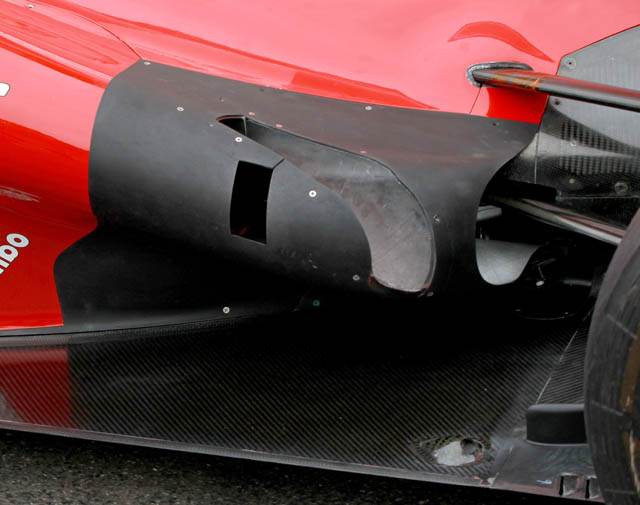
Ferrari ran a revised exhaust exit at Hockenheim the position and exit were similar to earlier versions but only a single additional cooling slot featured. Like other designs the cooling slot is linked by a slit in the bodywork to the exhaust canal, meaning that is counts as a single opening.

A new front wing appeared in Germany, here we get a good look at it from a couple of unusual angles, from the top you can see the number of elements in the wing, it is incredible how the complexity of front wings has increased since the current generation of aerodynamic regulations was introduced in 2009. From the underside you can see the most important surfaces. Note the strake design and also how the camera position complements the wing itself.

Ferrari fitted a very nice set of small turning vanes at the base of the main sidepod turning vane.
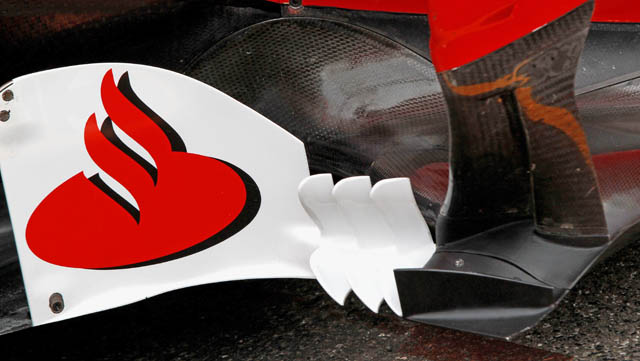
The three vertical elements are very sculpted and likely the result of PIV work at the TMG wind tunnel in Cologne.
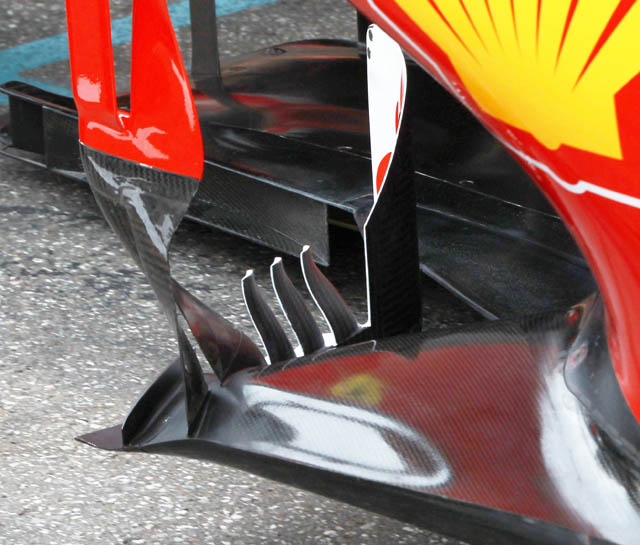
A nice view of the diffuser and related aero parts at the rear of the F2012, not the sculpted upper element and the Toyota syle serrated lower rear wing end plate.

Hungaroring
Car 5: 296
Position: 5th
Driver: Fernando Alonso
Car 6: 294
Position: 9th
Driver: Felipe Massa
Stefano Domenicali:“Definitely a case of the glass being half full! Fifth place for Fernando has allowed him to extend his lead in the classification, which is a very important achievement on a weekend in which we definitely did not have the performance to fight with the best. It was a very hard race, decided for the most part by grid positions and the start, with the only variables concerning tyre degradation and the different strategies adopted. I think that, as far as the latter is concerned, we made the right choices, which resulted in Fernando getting ahead of at least two cars that were quicker than his. In fact, it was the start that had a negative effect for Felipe: the places he lost then could not be made up, despite having a race pace that matched those ahead of him. As I said at the start, the outcome of this weekend is not a negative one, but clearly we need to look closely at the way the weekend went as a whole to discover the reasons why we were not as competitive as in the last few races. Now we still have a week of work before the summer break: there’s a lot to do to reduce the performance gap and to be as well prepared as possible for the last two races still to be run in Europe. At Spa and Monza we will race in very different conditions and at very different tracks to Budapest, so anything can happen. It will be important to be ready for every eventuality. We will be able to take a breather for a few days, but I’m sure all our guys have just one thought in mind…”
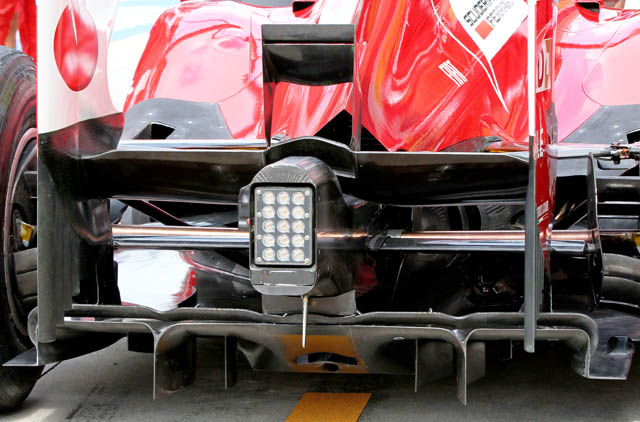
Another good look at the F2012 diffuser, note the double element ‘monkey seat’ winglet.
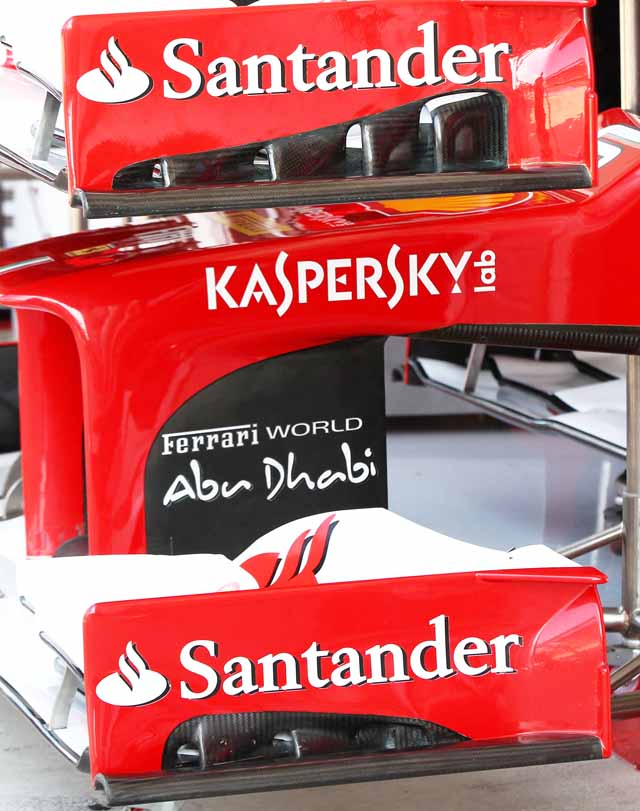
A new front wing endplate made its debut in Hungary, compare the older specification with the new version in the picture above. The vents in the endplate seem to be a major focus for the Italian team.
Spa-Francorchamps
Car 5: 296
Position: DNF (Grosjean)
Driver: Fernando Alonso
Car 6: 294
Position: 5th
Driver: Felipe Massa
Stefano Domenicali: “First, the good news: Fernando is fine. All of us and I think also all Ferrari fans went through a heart-stopping moment after the accident, especially as we could not communicate with him. Only when we saw him emerge from the cockpit could we let out a first sigh of relief and then we began to breathe normally when we saw him make it back to the garage. Clearly, after that came the great disappointment at what had happened at the start, because it was within our ability to get the podium finish that was our target after yesterday. Today, the F2012 had a good pace, as Felipe demonstrated, driving a great race. We are happy for him, because a good result is just what was required at this point of the season. As for the accident, I can only say that the judgement falls to the FIA: what is certain is that, it would be better if, starting with the junior formulae, rules relating to on-track behaviour were enforced in an inflexible manner, so as to have drivers as well prepared as possible when they reach this, the highest level of motor sport. My duty, as head of the team is to ensure everyone focuses on their own tasks, especially at difficult times: therefore now we must quickly put this day behind us and look to the next Grand Prix, the one in Monza, a track that is particularly dear to us.”
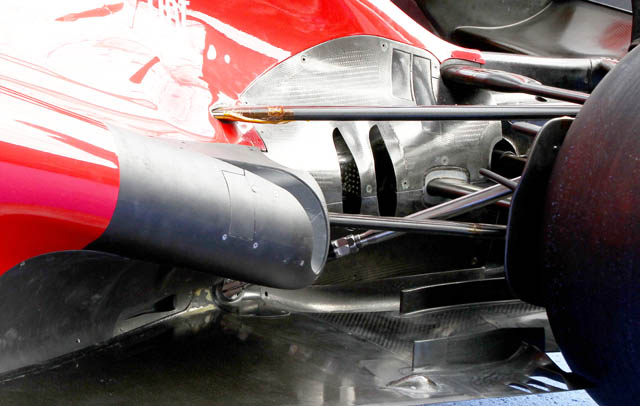
A good look at the critical blown diffuser area of the F2012, the exhaust gasses are channeled to a space just inside of the rear wheel (possibly via the slots in the floor) and prevent the vortex from the tyre entering the diffuser area. This effect only really takes place on throttle as off throttle blowing is essentially banned. Note the additional cooling hole is blanked off in this picture.

A new front wing was run at Spa with revised rear element
Monza
Car 5: 296
Position: –
Driver: Fernando Alonso
Car 6: 294
Position: –
Driver: Felipe Massa
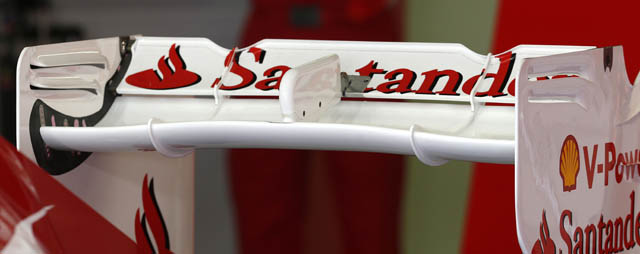
A look at the low drag rear wing used on the F2012 at Monza.
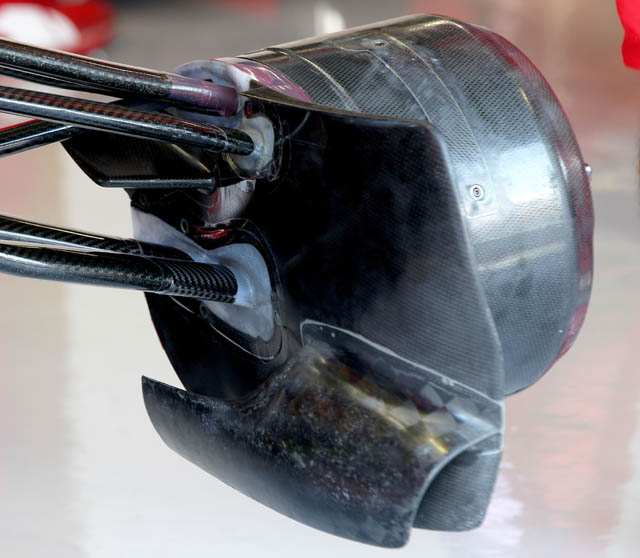
Much of the aero has to be changed for Monza with high average speeds these brake ducts are more about flow conditioning than downforce generation (we think!)

